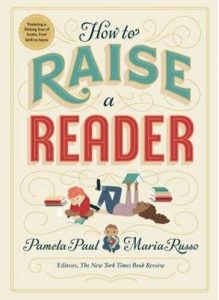How to Raise a Reader
How to Raise a Reader
By: Pamela Paul and Maria Russo

Workman Publishing 2019 (202 pages)
Pamela Paul and Maria Russo are both editors of The New York Times Book Review. They focus on practical tips on how to develop children into lifetime readers. One of the most important aspects of raising a reader is to lead by example. You must be a reader yourself! This book is a great read for parents, teachers, or grandparents learning how to teach readers to enjoy reading, rather than reading because they “have to” read. Pleasure reading is started at the infant stage, but it is never too late to start developing a reader.
It is important to read aloud to your infant child. The content of the book isn’t that crucial. Research shows that the number of words an infant is exposed to has a direct effect on language development and literacy. It doesn’t really matter at this stage that they understand the words, the most important thing is that the words are directed to the child from a live person, not a recording or television program. It is all about someone reading to the infant.
As a child grows to a toddler, they still benefit from hearing words but they go beyond just hearing words. They are learning what the words mean and how to apply the words to the world around them. Toddlers are absorbing everything being read to them like colors, shapes, manners, rules, numbers and other kinds of useful facts. Reading out loud at this stage becomes more interactive with the child by pointing at colors or animals and turning pages. Provide a bookshelf for the child with an assortment of books so they can start selecting which books to read.
As the age of a child progresses, so does this book. There are ideas for taking the next steps of having the child begin reading by themselves and then continue to develop as an independent reader. There are more ideas and suggestions on how to keep them reading for enjoyment and introducing them to reading at the library or meeting an author at a local bookstore. Help your child select books of interest at this stage and be aware of what can make an emerging or independent reader become frustrated and not enjoy the reading experience.
Once an independent reader has been created, the next level of reading is “middle-grade” books. At this stage, children begin to discover who they are themselves and find out more about subjects they are interested in. This is the age where you allow a child to stop reading a book if it is not interesting to them. Never treat books like a chore and just help guide the choice.
The last development stage in this book is the teen reader exploring the young adult books. These books can be an adjustment for parents because the content can be a little edgy and address troubling behavior, violence, dialogue, and sexuality. Continue to provide books that interest your child and continue to be an example by being a reader yourself.
Another bonus that this book offers are book suggestions at every stage of reading from infant through teenage years. There’s a great list to help find the right book at the right time!
